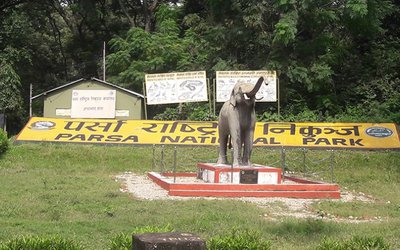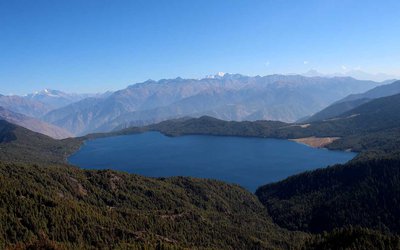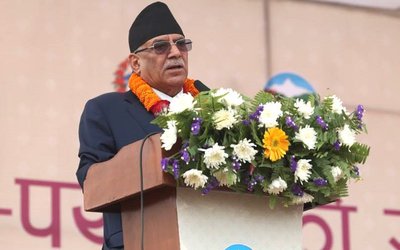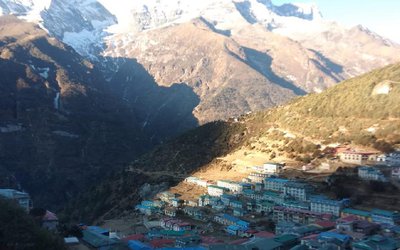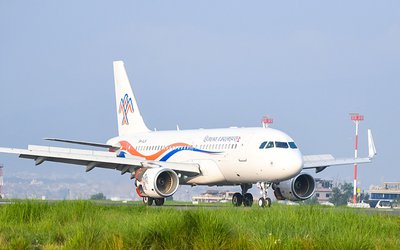If the last nine months of tourist arrivals by air are any indication, they show that Nepal’s tourism is in the stage of a high growth. After a lull over decades of constraints in tourist infrastructure, the hotel industry has also found a time to put the money into expanding and improving infrastructure.
As the number of tourist arriving in Nepal increases, the hotel rates have also gone up. More international airlines are connecting Nepal with different capitals of the world. Had Nepal got its own airlines and aircraft; the arrival would certainly have increased further.
Despite the lack of aircraft with Nepal Airlines, the country’s national flag carrier, more than ninety percent of hotels have already been booked for September and October. According to Hotel Association of Nepal, tourist arrivals increased drastically.
As tourists increase, the room rates at hotels around the country have gone up. Local hoteliers in Pokhara have raised the rate of Hotel rooms by 40 percent for this season.
“Our rooms are still cheaper than that of other countries around the world,” said Bharat Raj Parajuli, vice president of Western Regional Hotel Association and a hotel owner.
Be it due to the effects of sustained peace in the country or the Nepal Tourism Year campaign, tourism is on a rising trend.
“This is the dividend of peace. If political parties support fully in helping maintain law and order and peace, Nepal’s arrivals will increase by many folds,” said Pasiddha Bahadur Pandey, chairman of Hotel Association of Nepal.
“Nepal has enough prospects to bring more tourists. Compared to the last few years, the hotel business is in a better shape this time.”
Only about 4.4 million tourists visited Nepal during the Maoist insurgency from 1996 to 2006.
Nepal witnessed an encouraging rise in tourism after the civil war came to an end and effects were felt immediately. Some 526,705 tourists visited Nepal on 2007, 37.2 percent more than the previous year 2006.
However, in 2008, the total number of tourists that arrived in Nepal fell by 5 percent. Some 500,000 visited that year. Now, that decreasing trend looks like a distant history.
From 2009 the number of tourists visiting Nepal has proliferated. In 2009, the number increased slightly to 509,956 with annual growth rate of 1.9 percent.
In 2010, figures reached new heights and exceeded 6 lakhs for the first time in the history of Nepal: 602,867 arrived that year with annual growth rate of 18.2 percent.
Against the backdrop of such promising and encouraging figures, Nepal entered Nepal Tourism Year (NTY) 2011 with a target to bring about 1 million tourists— 700,000 tourists via air and 300,000 tourists via land routes. Given the rise in tourism after the civil war, the goal all but looked achievable. But, there were uncertainties and doubts looming as the target looked a bit implausible considering the limited number of flights that used to fly into the country at that time, the limited accommodation capacity of hotels, lack of infrastructure to attract tourists and the deficiency of needed promotional activities in the international market before the tourism year.
Tourism Industrialists have worked hard from the outset in order to achieve such an ambitious target. Total numbers of flights into the country were increased. Infrastructures to carry tourists from land were improved. Hotels -- from five star to roadside lodges -- have worked hard and expanded their accommodation capacity by spending loads of money. Promotional campaigns were amplified in the international market at the latter months of this year. Meanwhile, peace is sustained in the country despite political uncertainties. So, due to the all-round effort, Nepal is close to achieving its goal, which at one time looked unachievable.
Despite political instability with frequent changes in the government, tourist arrivals continue to increase.
“As long as there is peace in the country, political instability is not an issue for tourism. Tourists are least concerned about the political situation if it is not a violent one. They don’t want their tour itinerary to be disturbed by banda, chakkajam and other violent activities,” said Aditya Baral, Director of Public Relations and Publicity Department. “We are nature based destinations. We cannot change the topography of our country. Hence, the tourism here does not connote changing the products, it is more abut changing the perception through proper presentation supplementing it with more value addition.”
Current Scenario
As of September 2011, the total number of tourists that have arrived in Nepal has exceeded seven lakhs and with three more months remaining, Nepal is on the course to touch the magical 7 digit number as the major Tourist Season is just about to begin.
According to the data released by tourism organizations, Nepal is about to welcome an overwhelming number of tourists as around 90% of hotels in and around Kathmandu valley and in the major tourist destinations have already been booked for the upcoming tourist season. Although the tourist season starts early October and ends late November, hotels are fully booked. This has raised hopes and tourism businessmen are very optimistic about Nepal achieving its 1 million tourist goal for the year.
“Thanks to the last one year’s efforts, the number of tourist arrivals has increased. Nepal still needs to do a lot of work to bring a million tourists. The recent trend of arrival shows that the target to bring a million tourists is possible,” said Yogendra Shakya, coordinator of Nepal Tourism Year 2011. “If we are able to maintain the present level of peace in the country, we don’t need to worry about the number of tourists.
Budget Effects
Lack in promotional activities about the Nepal Tourism Year in international arena during previous years and even early months of this year affected the total tourist arrivals which could have gone up further by at least a few percent. The promotional campaign kicked off quite late due to delay in promulgation of budget.
At the same time, the government has increased the budget in this sector by 25 percent for the Fiscal Year (FY) 2011-12 compared to FY 2010-11.
Promotional Activities
Although promotional activities were stalled during the early months of the year, after the budget was promulgated, the campaign took off at a rapid pace.
A few months back, Nepal Tourism Board stated that NRs 130 million out of NRs 230 million (for tourism) announced in this year’s budget will be used for promotional activities. NRs 30 million was planned to be spent on promotional activities in China, NRs 60 million in India and the remaining NRs 40 million in other countries, which included advertising in CNN and BBC.
Officials of Nepal Tourism Year (NTY) 2011 Implementation Committee said that over three dozen promotional activities were successfully completed in international markets over the first six months of 2011. Since the outset of NTY 2011, Nepal has taken part in 25 international tourism fairs—seven in Europe, two in America, six in India and ten in Asia.
Promotional programs were also organized in Melbourne, London, Munich, Bonn, Paris and other cities in coordination with Nepali diplomatic missions and Non-resident Nepalis Association.
International TV channels will start broadcasting Nepali promotional ads after mid-September. Likewise, Nepal Tourism Board has also placed promotional posters of NTY 2011 in metro buses in DC metro, USA.
Revenue woes
Average income has been recorded as high as $79.1 per tourist per day in 2003. However, from 2003, revenue generation is all downhill. In 2004, it declined to $45.1. Despite a little rise, the decreasing trend continued in the succeeding years at $58.5 and $55.
The average income from each tourist was $45 and $73 in 2007 and 2008 respectively. On an average, a tourist spent $65.3 in 2009. In 2010, it dropped to $43.2.
Nepal earned nearly NRs 29 billion through tourism in 2009 which was reduced to NRs 23.43 billion in 2010.
Tourism entrepreneurs complain that the problem has continued even this year, as the total earning from tourism has declined by 12.5 percent during this period. The average length of stay of tourists in Nepal has increased but the revenue has been on the weaker side. Although there has been a rise in the number of tourists this year, the majority of them are Chinese and Indian tourists. The number of high-profile European and American tourists coming to the country has decreased. This is one of the reasons for the decrease in revenues, despite increase in the number of tourists.
Growth in International Tourism
International tourism also saw a rise in the first half of 2011, as tourism grew by almost 5 percent, totaling a new record of 440 million arrival,s which is 19 million more than in the same period of 2010.
Growth in advanced economies (+4.3 percent) has maintained strength and is closing the gap with emerging economies (+4.8 percent), which have been driving international tourism growth in recent years. This trend reflects the decreases registered in the Middle East and North Africa, as well as a slight slowdown in the growth of some Asian destinations following a very strong 2010.
“The sustained growth registered in tourism demand in such challenging times clearly makes the case for the sector and reinforces our call to consider tourism as a priority in national policies. Tourism can play a key role in terms of economic growth and development, particularly at a moment when many economies, for the most part in Europe and North America, struggle for recovery and job creation,” said UNWTO Secretary-General, Taleb Rifai.
With a growth +6 percent, the Americas were slightly above the world average, with remarkably strong results for South America (+15 percent). Asia and the Pacific grew at a comparatively slower pace of 5%, but this more than consolidates its 13% bumper growth of 2010.
Conclusion
Amidst skepticisms about the goal of NTY 2011 being achievable, tourism year is quietly reaching towards its goal. In the upcoming months --in which the tourist arrival is maximum -- Nepal is expected to land more than 3 lakhs tourists, which is enough to surpass the tourism year goal. But, still loads of hard work are needed to turn the expectation into reality. If Nepal could reach the 1 million mark, it would be the moment for celebration and could mark a new beginning in the Nepalese Tourism history.
Industrialists should follow the determination that they have shown in this year and carry this momentum to the upcoming years and establish tourism as the backbone of the economy of the nation.
- TANAHU HYDROPOWER PROEJCT: A Significant Achievement
- Apr 15, 2024
- AMBASSADOR HANAN GODAR: Sharing Pain With A Nepali Family
- Mar 30, 2024
- VISIT OF KfW AND EIB TO NEPAL : Mission Matters
- Mar 25, 2024
- NEPAL BRITAIN SOCIETY: Pratima Pande's Leadership
- Mar 24, 2024
- NEPAL ARMY DAY: Time To Recall Glory
- Mar 15, 2024


